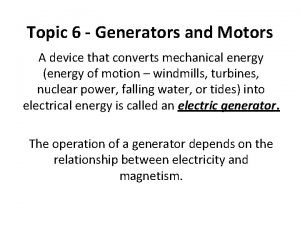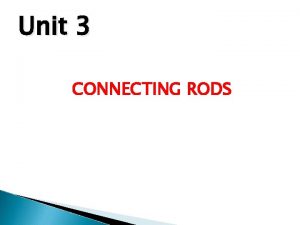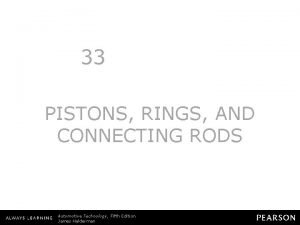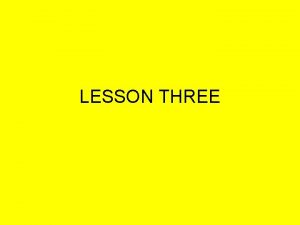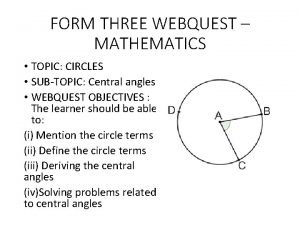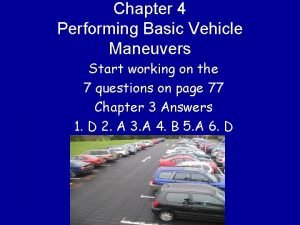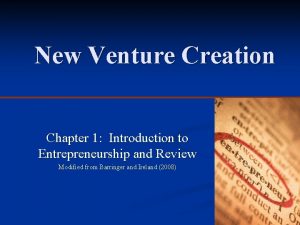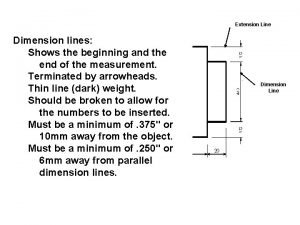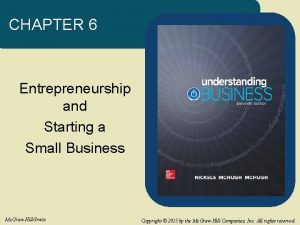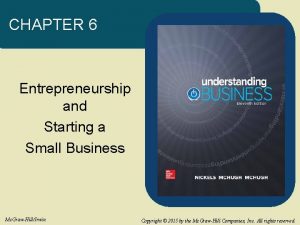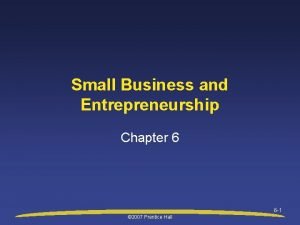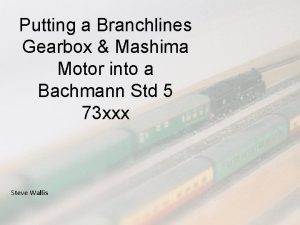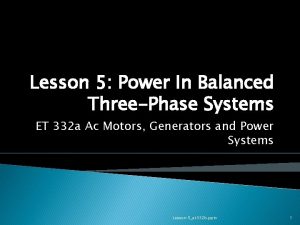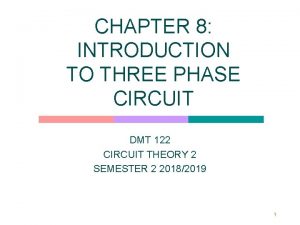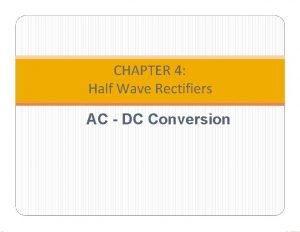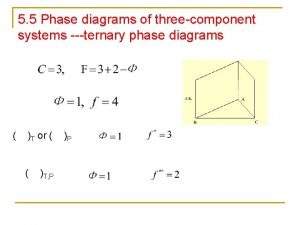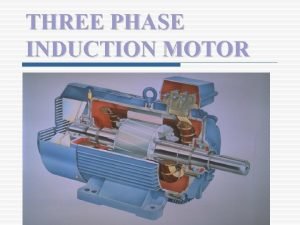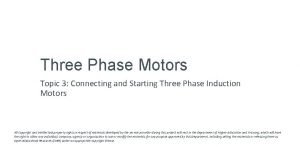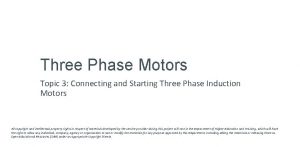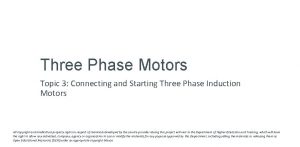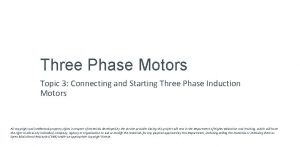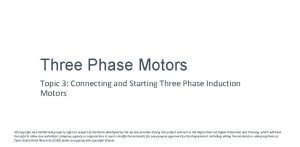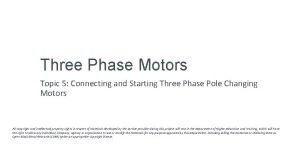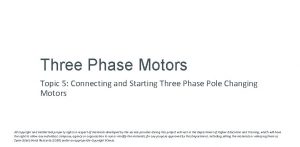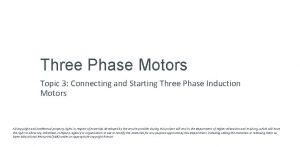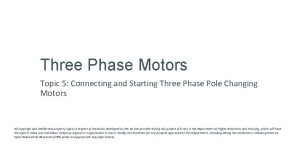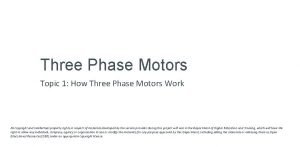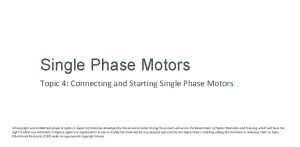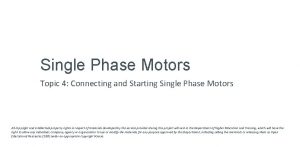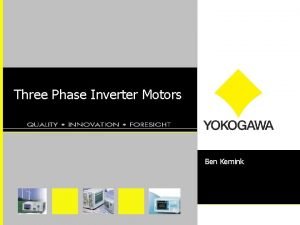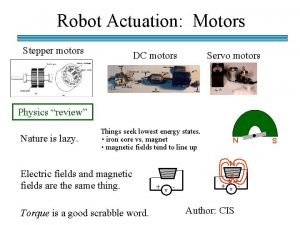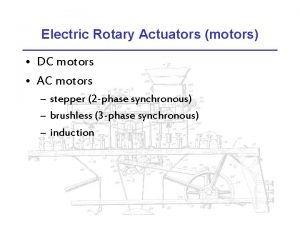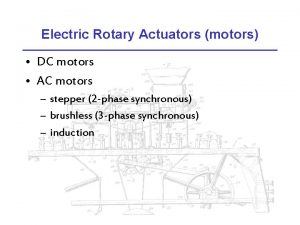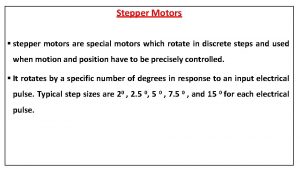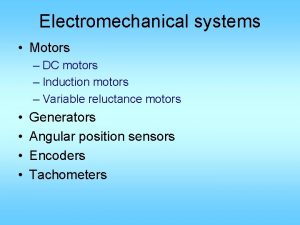Three Phase Motors Topic 4 Connecting and Starting













































- Slides: 45

Three Phase Motors Topic 4: Connecting and Starting Three Phase Slip-Ring Motors All copyright and intellectual property rights in respect of materials developed by the service provider during this project will vest in the Department of Higher Education and Training, which will have the right to allow any individual, company, agency or organisation to use or modify the materials for any purpose approved by this Department, including selling the materials or releasing them as Open Educational Resources (OER) under an appropriate copyright license.

Assumed prior learning 05_01_00 05_01_02 05_02_01

Outcomes By the end of this unit the learner will:

Unit 4. 1: Slip-Ring Resistance Starter

Topic Introduction In the previous topic we learnt how to connect and start ordinary squirrel cage induction motors. In this topic, we are going to learn about starting slip-ring motors. Remember that slip-ring motors have wound rotors and that these coils can be connected to external resistances via three slip-rings. Img 01

Introduction When we first learnt about slip-ring motors in topic 1 of this course, we learnt that they are useful because they allow us to reduce the amount of current drawn by the motor during start up. Watch the video to learn more about the starting advantages of slip-ring motors. Img 02

A quick summary Here is a quick summary of what we learnt in the previous unit. Click each point to see the next one. Motors can draw lots of current when they start up, 1 especially under load. We can limit the amount of current drawn if we limit 2 the current in the rotor by adding resistance. As the motor gains speed, we remove this resistance 3 bit by bit. Once the motor is running all rotor resistance is 4 removed and the motor runs like a squirrel cage motor.

Resistance starter For slip-ring motors to provide their potential starting benefits, we need to add resistance to the rotor coil circuits. This limits the amount of current in the rotor (and stator) windings and means that the motor does not draw as much current at start-up as a squirrel cage motor. The simplest way to do this is with a resistance starter If we did not add any resistance to the rotor coils, the slip-ring motor would start just like a normal squirrel cage motor.

Speed control It is also possible for us to use the resistances added to the rotor coils of a slip-motor to control its speed. Img 03 We will see in a later unit how this works.

Resistance starter basics To wire a resistance starter, we usually need 4 contactors – one main contactor and three resistance contactors. The resistance contactors add or remove three sets of rotor coil resistors. 1 Main Contactor Click on the buttons to find out more about the 2 Resistance Contactors resistance starter. 3 Rotor and Stator Connections

Safety first When you work with motors you must put your safety and the safety of others first. You must complete the necessary Hazard Identification and Control (HIAC) Form. Need help with HIACs? Click the button to go to Topic X in The World of an Electrician Get help with HIAC Forms

Before We Begin Before you do any work on a motor, you must make sure that you have isolated and locked out the supply to the motor. Make sure you know how to do this by referring to Topic X in The World of An Electrician. Learn about Isolating and Lock-Out Procedures

The main circuit Remember that the main circuit is very similar to the DOL starter for a squirrel cage motor. Click on the image to see how the motor is connected to the supply and how the resistors are connected to the rotor circuit. Img 06 See how the main circuit is wired

Upload a your circuit Draw your own copy the main circuit diagram for a slip-ring resistance starter. Make sure to include the motor’s connection to power as well as the rotor circuit. Choose image Upload

Wire it up Now, practice wiring the motor to the supply and the resistors to the rotor circuit using the motor wiring simulator. Click on the image to open the motor wiring simulator. Img 08

The basic control circuit We usually use timers to automatically cut out the rotor circuit resistors as the motor starts. For now, however, lets look at the basic control circuit without these timers. We will add them later on. Click on the image to see the basic slipring resistance starter control circuit. Img 09

Cut out the resistors Here is an interactive wire diagram to play with. 1. Click on the image to open the interactive diagram. 2. Click on the START button to start the motor. 3. Click on the switches to cut out each set of resistors in turn. Img 10

Let’s make it automatic Now, let’s add in some timers to make the process automatic. Remember timers can have NO or NC contacts that switch state a set time after energisation or de-energisation. See a refresher on timers See if you can design an automatic resistance starter control circuit using 3 timers. Click on the button if you need a refresher on the basics of timers.

What is a timer? Timers or time-delay relays are special components that allow us to control when specific events happen in our motor circuits. Like contactors, they have a coil and NO and NC contacts. There are 2 main types. Click each box to find out more. 1 ON Delay The contacts change state a set time after the coil is energised. 2 OFF Delay The contacts change state a set time after the coil is de-energised.

ON delay timers Here is an ON Delay timer with a NO and a NC contact. Let’s see how it works. Set the timer and then energise and de-energise the coil to see what happens to the contacts. Set Time 3 s Energise coil 3 s NC ON Delay contact NO ON Delay contact

OFF delay timers Here is an OFF Delay timer with a NO and a NC contact. Let’s see how it works. Set the timer and energise and then de-energise the coil to see what happens to the contacts. Set Time 3 s Energise coil 3 s NC OFF Delay contact NO OFF Delay contact

How do you wire timers into circuits? We wire timers into control circuits just like contactors and relays. Watch the video to see how to wire ON and OFF Delays into control circuits and how to represent them in your diagrams. Img 11

A summary Here is a summary of 4 different types of timer contacts. Click on each box for more information. ON Delay OFF Delay NO Normally Open, NOTC Timed Close Normally Open, NOTO Timed Open NC Normally Closed, NCTO Timed Open Normally Closed, NCTC Timed Close

Normally Open, Timed Close (NOTC) This is an ON Delay contact. In this example… • the contact closes 5 seconds after the coil is energised • the contact opens immediately when the coil is de-energised

Normally Closed, Timed Open (NCTO) This is an ON Delay contact. In this example… • the contact opens 5 seconds after the coil is energised • the contact closes immediately when the coil is de-energised

Normally Open, Timed Open (NOTO) This is an OFF Delay contact. In this example… • The contact closes immediately when the coil is energised • The contact opens 5 seconds after the coil is de-energised

Normally Closed, Timed Close (NCTC) This is an OFF Delay contact. In this example… • The contact opens immediately when the coil is energised • The contact closes 5 seconds after the coil is de-energised

The automatic resistance starter Did you manage to design an automatic slip-ring resistance starter? See how your design compares to this one. Watch the video explaining the design and working of the automatic slip-ring resistance starter. Img 11

Upload a your circuit Draw your own copy of the slip-ring resistance starter control circuit. Make sure to include the necessary circuit overload protection. Choose image Upload

How do you wire the resistance starter? Wiring the slip-ring resistance starter control circuit can be quite tricky because of all the parallel circuits. Watch the video to see how to wire the slip-ring resistance starter control circuit. Img 13

Wire it up Now, practice wiring the slipring resistance starter control circuit using the motor wiring simulator. Click on the image to open the motor wiring simulator. Img 14

Video Briefing – Vid 01 Animated video based on Vid 01 from 07_03_06. We learnt in the previous topic that when induction motors start up they draw large amounts of current: 1. Current in the coils of the stator creates a rotating magnetic field. 2. This rotating magnetic field cuts the bars of the rotor and induces a current in these bars by electromagnetic induction. 3. This induced current creates a magnetic field in the rotator which tries to align with the stator rotating magnetic field causing the rotor to spin. 4. Remember that the greater the rate of change of the magnetic field cutting a conductor, the greater the current induced. 5. At start-up, the rate of change of the stator field cutting the rotor bars is very high because the difference in the speed of the stator rotating field and the rotor is very big. Therefore the current induced in the rotor bars is very high.

Image Briefing – Img 06

Video Briefing – Vid 02 A demonstration video presented by an experienced electrician showing how to wire a slipring motor resistance starter (based on diagram in Img 06). 1. Connect the motor to power via the main contactor and connect the stator according to the nameplate (star or delta) 2. Connect the rotor circuit to the 3 sets of resistors (or resistor box/es) and wire in the three resistor contactors, connecting in star 3. At this point explain what these resistance starter resistors usually look like and show examples 4. Connect the ends of the resistor conductors in star 5. As these steps are done, draw the corresponding main circuit diagram as per Img 06. Make sure to emphasis the symbol of slip-ring motor ad how it differs form ordinary squirrel cage induction motor symbol

Instructions 1. To add a wire between 2 points, click the starting connection and then click the ending connection. 2. To delete a wire, click on it and then click the Delete icon in the top right corner. 3. To change the colour of a wire, click on it and then click on the colour. 4. To move a component, click and drag it to a new position. Practice Connect the motor protection circuit breaker up to the contactor L 1 T 1 L 3 T 2 T 3 MPCB T 1 L 2 L 3 Test A 1 Forward T 2 T 3 A 2 N O N C

Wire the 3 P motor according to the main circuit diagram. L 1 L 2 L 3 Overload Relay T T T 1 2 3 L 1 L 2 L 3 T 2 T 3 N O N C L 1 L 2 L 3 T 2 T 3 L 2 L 3 A 1 Contactor. R 1 T 1 L 1 T 2 L 2 T 3 L 3 A 2 A 1 Contactor. R 2 A 1 Contactor. M T 1 N C MPCB T 1 L 1 N O R W B A 2 N O T 1 N C A 1 N C B 1 T 2 C 1 3 M E D F T 3 A 2 N O N C L 1 L 2 L 3 A 1 Contactor. R 3 T 1 T 2 T 3 A 2 N O N C Test Instructions Print Circuit Diagram

Wire the 3 P motor according to the main circuit diagram. L 1 L 2 A 1 L 3 Contactor. M T 1 T 2 L 1 T 3 L 2 A 2 L 3 Overload Relay T T T 1 2 A 1 3 B 1 D 1 E 1 N C N O N C C 1 F 1 L 3 T 2 T 3 MPCB T 1 L 2 L 3 A 1 Contactor. R 2 T 1 L 2 L 3 A 1 Contactor. R 1 T 1 3 M E N O L 2 R W B T 2 T 3 A 2 N O N C Test L 1 L 2 T 1 T 2 L 3 A 1 Contactor. R 3 T 3 A 2 N O N C Instructions Print Circuit Diagram

e Briefing – Img 09 -Stop -Start -K 1 = main contacto -R 1 = resistance con Switch -R 2 = resistance con -R 3 = resistance con -K 1 -R 2 -R 3

Interactive Briefing – Int 02 Explanation Resistor set 3 Resistor set 2 Resistor set 1 Connected Cut out

Video Briefing – Vid 03 (1 of 2) A screencast/animation video presented by an expert electrician explaining the design and operation of the automatic slip-ring resistance starter (see 2 of 2). 1. Start with the basic control circuit in Img 09. 2. Add the timer T 1 and NO K 1 contact to prevent T 1 being energised until K 1 is energised – explain how/when this timer gets energised. 3. Add T 1 NOTC contact in series with contactor R 1 – explain how/when this contactor gets energised. 4. Add in timer T 2 and a NO R 1 contact in series with it – explain how/when T 2 gets energised. 5. Add T 2 NOTC contact in series with R 2 - explain how/when this contactor gets energised. 6. Add in timer T 3 and a NO R 2 contact in series with it – explain how/when T 3 gets energised. 7. Add T 3 NOTC contact in series with R 3 - explain how/when this contactor gets energised.

Video Briefing – Vid 03 (2 of 2)

Video Briefing – Vid 04 Demonstration video of an expert election wiring the slip-ring resistance starter control circuit step-by-step according to the circuit diagram developed/explained in Vid 03.

Instructions 1. To add a wire between 2 points, click the starting connection and then click the ending connection. 2. To delete a wire, click on it and then click the Delete icon in the top right corner. 3. To change the colour of a wire, click on it and then click on the colour. 4. To move a component, click and drag it to a new position. Practice Connect the motor protection circuit breaker up to the contactor L 1 T 1 L 3 T 2 T 3 MPCB T 1 L 2 L 3 Test A 1 Forward T 2 T 3 A 2 N O N C

Wire the 3 P motor according to the main circuit diagram. L 1 Brea ker 2 T Brea ker 1 T 1 L 1 A 1 K 1 A 2 A 1 T 1 A 2 Start Stop 1 L 2 L 3 Overload Relay T T T 1 R W B 2 3 N O N O N O N C A 1 R 1 A 2 N O N C A 1 T 2 A 2 Test N O N C A 1 R 2 A 1 T 3 A 2 N O N C A 1 R 3 A 2 N O N C Instructions Print Circuit Diagram

Wire the 3 P motor according to the main circuit diagram. L 1 L 2 L 3 Overload Relay T T T 1 2 3 N O N C R W B L 1 Brea ker 2 T Brea ker 1 T 1 1 Start Stop A 1 K 1 A 2 N O A 1 N O R 1 A 1 T 1 A 2 N O N C A 1 T 2 A 2 R 2 A 2 N O N C N O Test A 1 N C R 3 N C A 2 A 1 T 3 A 2 N O N C Instructions Print N O N C Circuit Diagram
 Lesson 4 three-phase motors
Lesson 4 three-phase motors Generators and motors
Generators and motors How everything
How everything Paragraph writing strategies
Paragraph writing strategies Topic about internet
Topic about internet Mobile phase and stationary phase
Mobile phase and stationary phase Mobile phase in chromatography
Mobile phase in chromatography Which detector used in hplc
Which detector used in hplc Normal phase vs reverse phase chromatography
Normal phase vs reverse phase chromatography Hplc reverse phase vs normal phase
Hplc reverse phase vs normal phase Normal phase vs reverse phase chromatography
Normal phase vs reverse phase chromatography Phase to phase voltage
Phase to phase voltage In a triangle connected source feeding a y connected load
In a triangle connected source feeding a y connected load Csce 441
Csce 441 Connecting stalk and umbilical cord
Connecting stalk and umbilical cord Connecting rod diagram
Connecting rod diagram Contrast cause and effect
Contrast cause and effect Connecting rod material
Connecting rod material Connecting a verbal description to table and graph
Connecting a verbal description to table and graph Pistons rings and connecting rods
Pistons rings and connecting rods The cleft connecting the nose and mouth to the larynx
The cleft connecting the nose and mouth to the larynx Name a segment skew to de
Name a segment skew to de Fork and blade connecting rods
Fork and blade connecting rods Form three topic
Form three topic Topic two
Topic two Chapter 4 performing basic maneuvers page 28 answer key
Chapter 4 performing basic maneuvers page 28 answer key Creating and starting the venture
Creating and starting the venture Alphabet of lines
Alphabet of lines Starting and derived positions
Starting and derived positions Chapter 6 entrepreneurship and starting a small business
Chapter 6 entrepreneurship and starting a small business Chapter 6 entrepreneurship and starting a small business
Chapter 6 entrepreneurship and starting a small business Chapter 6 entrepreneurship and starting a small business
Chapter 6 entrepreneurship and starting a small business What is fundamental position
What is fundamental position Small busness loans
Small busness loans Mashima motors and gearboxes
Mashima motors and gearboxes Step motors and control systems
Step motors and control systems Smart sensor abb
Smart sensor abb Units of torque
Units of torque Nascar motors assembles and sells motor vehicles
Nascar motors assembles and sells motor vehicles Fixed interval schedule example
Fixed interval schedule example Ac systems lesson 5
Ac systems lesson 5 A balanced delta connected load having an impedance 20-j15
A balanced delta connected load having an impedance 20-j15 Single phase controlled rectifier with rl load
Single phase controlled rectifier with rl load Three component system phase diagram
Three component system phase diagram Rotor frequency formula
Rotor frequency formula Three phase system
Three phase system

